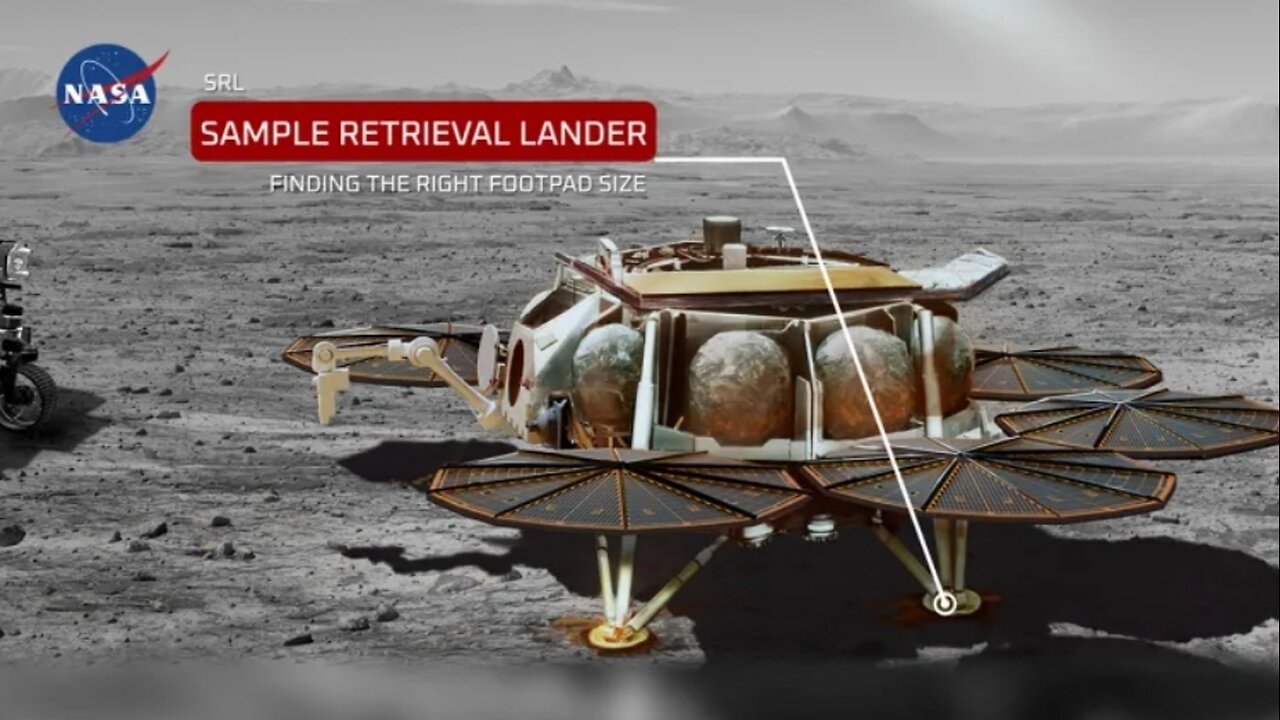Premium Only Content

Testing Mars Sample Return: Finding the Right Footpad Size for the Sample Retrieval Lander
The first leg of Mars Sample Return is underway, as Perseverance collects rock cores and other Mars samples at its landing site, Jezero Crater. Meanwhile on Earth, mission teams are optimizing the designs of the follow-on spacecraft that would retrieve these rock samples and bring them to Earth.
In this video, engineers use a special testing rig to focus on the full-scale footpad for the Sample Retrieval Lander. Finding the right size and characteristics for the lander footpads is critical to a safe touchdown. This lander would also serve as a launch platform for the Mars Ascent Vehicle rocket, which would carry the Mars samples collected by the Perseverance rover. The lander legs and footpad need to absorb the impact of the heaviest spacecraft (5,016 pounds or 2,275 kilograms) to touch down on the Red Planet.
Considered one of the highest priorities by the scientists in the Science and Astrobiology Decadal Survey 2023-2032, Mars Sample Return would be the first mission to return samples from another planet and provides the best and nearest opportunity to reveal the evolution of planets, life’s beginning in the solar system and the potential for ancient life. NASA is teaming with ESA (European Space Agency) on this important endeavor.
Animation is contributed by NASA’s Jet Propulsion Laboratory, the European Space Agency, Goddard Space Flight Center, and Marshall Space Flight Center.
Learn more about Mars Sample Return: https://mars.nasa.gov/msr
Learn more about the Sample Retrieval Lander: https://mars.nasa.gov/msr/spacecraft/sample-retrieval-lander/
TRANSCRIPT
3, 2, 1
[music]
TESTING MARS SAMPLE RETURN
SRL: SAMPLE RETRIEVAL LANDER - FINDING THE RIGHT FOOTPAD SIZE
PATRICK DEGROSSE JR.
MECHANICAL ENGINEER
Patrick DeGrosse Jr.: At the highest level, this test bed's objective is to ensure vehicle safety during the touchdown event and also to ensure that we have a stable platform later on in the mission for launching the rocket. We're able to vary impact energy and velocity and the way we do that in practice is by changing the amount of weights that we have on our pendulum and how high we lift the pendulum.
We use this data to inform the size of the footpad that we're planning to use in flight. We're trying to find the smallest footpad that does the job. 3, 2, 1, fire.
This is the first prototype that has a swiveling element to it. We're just going to be maturing those designs going forward and just getting more and more flight-like.
For more information on bringing Mars rocks to Earth: mars.nasa.gov/msr
-
 LIVE
LIVE
Rance's Gaming Corner
46 minutes agoTime for some RUMBLE FPS!! Get in here.. w/Fragniac
736 watching -
 23:55
23:55
CartierFamily
2 days agoElon & Vivek TRIGGER Congress as DOGE SHUTS DOWN Government
6.29K16 -
 5:43:44
5:43:44
Scammer Payback
2 days agoCalling Scammers Live
96.4K16 -
 18:38
18:38
VSiNLive
1 day agoProfessional Gambler Steve Fezzik LOVES this UNDERVALUED Point Spread!
79K10 -
 LIVE
LIVE
Right Side Broadcasting Network
10 days agoLIVE REPLAY: President Donald J. Trump Keynotes TPUSA’s AmFest 2024 Conference - 12/22/24
8,938 watching -
 4:31
4:31
CoachTY
18 hours ago $14.69 earnedCOINBASE AND DESCI !!!!
65.5K8 -
 10:02
10:02
MichaelBisping
17 hours agoBISPING: "Was FURY ROBBED?!" | Oleksandr Usyk vs Tyson Fury 2 INSTANT REACTION
18.7K8 -
 8:08
8:08
Guns & Gadgets 2nd Amendment News
2 days ago16 States Join Forces To Sue Firearm Manufacturers Out of Business - 1st Target = GLOCK
72.3K64 -
 10:17
10:17
Dermatologist Dr. Dustin Portela
2 days ago $16.41 earnedOlay Cleansing Melts: Dermatologist's Honest Review
103K6 -
 1:02:20
1:02:20
Trumpet Daily
2 days ago $34.12 earnedObama’s Fake World Comes Crashing Down - Trumpet Daily | Dec. 20, 2024
65.9K51